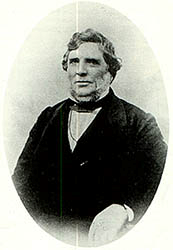
The Rating of Poets Х The Rating of Poems
William Kennish. Biography

William Kennish (born 1799, in Maughold, Isle of Man, died, March 19, 1862 in New York City), was a poet, engineer, explorer, scientist, and inventor. He acted as guide for an American Navy and Army led expedition approved by Congress to verify his Atrato-Truando river interoceanic canal route which linked the Pacific to the atlantic oceans in 1855.
Kennish was born in the Parish of Maughold, on the Isle of Man, in a cottage at Cornaa on the Douglas-Ramsey Road. He spoke Manx, and knew very little English until he became a seaman in the Royal Navy at the age of 22. He learned English and rose to the rank of Master Carpenter by the time he was 27. In October 1826, he married Mary Byford, of Gillingham, Chatham, Kent, England.
Between 1827 and 1832, while in the service of the Royal Navy, he invented a system ("A Method for Concentrating the Fire of a Broadside") for improving the aiming of naval artillery; and other inventions including a fuze for a shell and a system for floating naval artillery on to shore for land use. He invented a marine theodolite which was a key element of his improved Method. He proposed the practice of painting naval vessels grey to reduce the distortion and decay caused by solar radiation on black painted timbers. In addition, he worked on an artificial horizon for navigation; a[n] Automatic sounding instrument; a method of drowning the magazine of a ship of war ; an hydraulic ventilator; [and] a hydrostatic diving machine[.]"
When the Royal Navy became interested in steam propulsion, between 1832 and 1840, he designed several steam engines and an early screw propeller; but the Royal Navy did not take his ideas up. Disenchanted, he retired from the Royal Navy in November 1841. He worked for the Civilian Architect's Office at Woolwich Dockyard, London, until March 1844, when he and his family departed for the Isle of Man.
Whilst in the Royal Navy he had begun writing poetry, he said to while away the night watches after becoming almost bankrupt developing his inventions out of his own pocket. In 1843, under the patronage of two ladies of Castletown, Isle of Man, he submitted a collection of poetry for proofing to the Rev Robert Brown of Braddan, Isle of Man. Due to Robert's failing eyesight his son, T. E. Brown at the age of 14 did the proof reading. In 1844 this collection of poems, "Mona's Isle and Other Poems", was published in London and was promoted in newspapers on the Isle of Man. In 1845 he took up the post of parochial school master in Ballasalla and began teaching. This was not successful, and for a brief time in 1845 he was imprisoned for debt in Castle Rushen, Isle of Man.This did not affect his career because shortly after his debt was resolved and he conducted surveys of the coast line of the Isle of Man for the Royal Navy. Also about this time, he invented a buried tube system to convey messages, which became commonly used in America after he died.
In 1849, he emigrated to America. He soon began surveying gold-bearing land in Columbia, and in 1855 planned a route for an inter-oceanic Canal for the Hope Association of New York. His report on his survey of this proposed canal route was included in "The Practicality and Importance of a Ship Canal to Connect the Atlantic and Pacific Oceans", published in 1855 by George F. Nesbitt & Co. of New York.
William Kennish's Poems:
11286 Views
English Poetry. E-mail eng-poetry.ru@yandex.ru